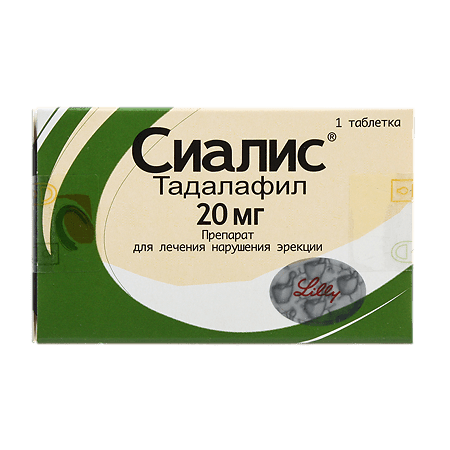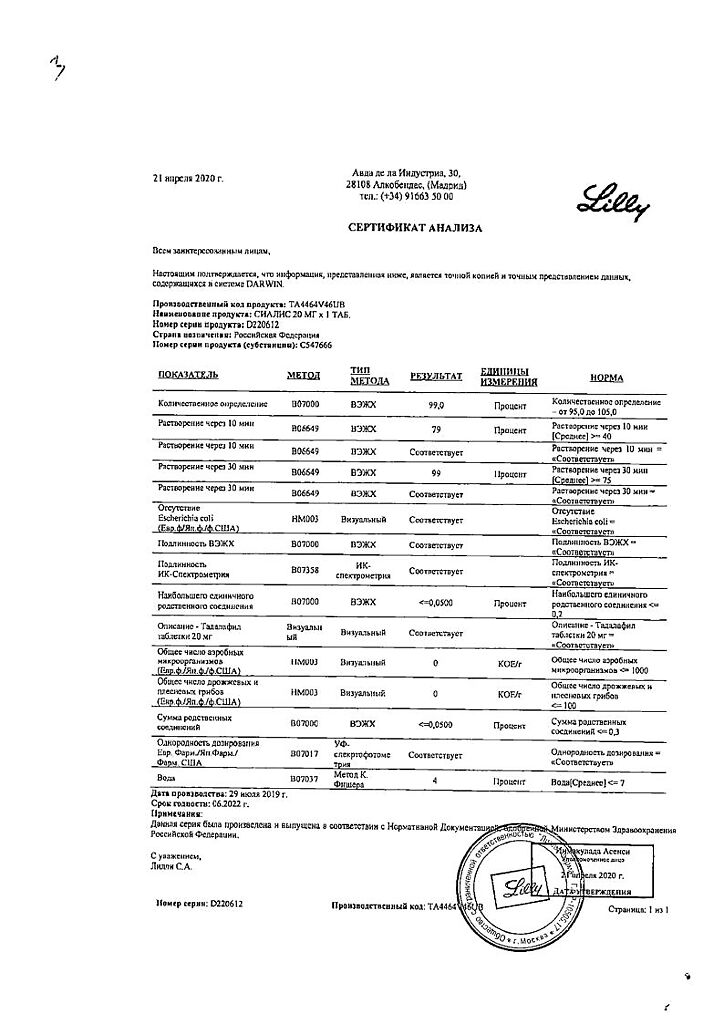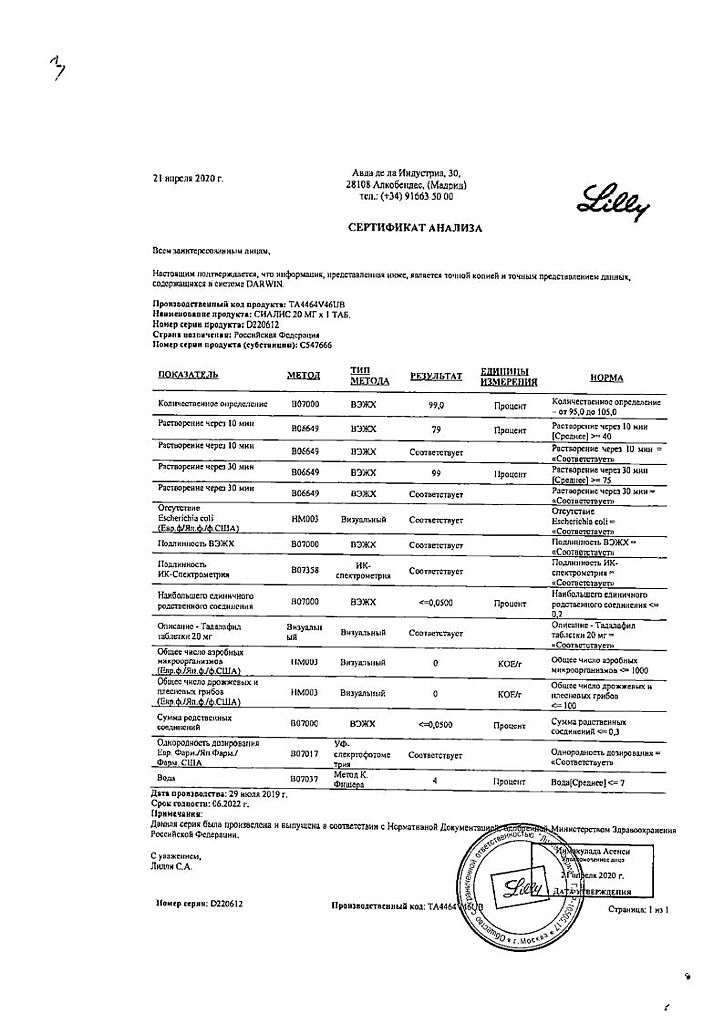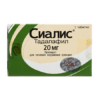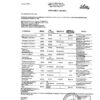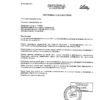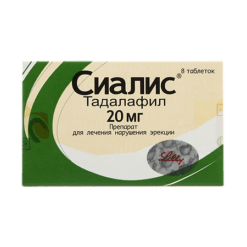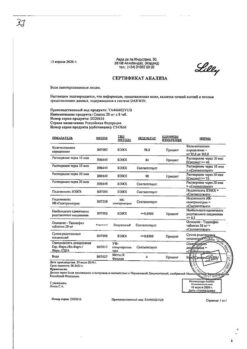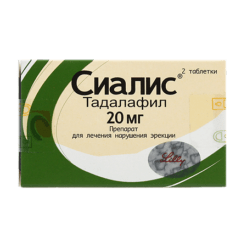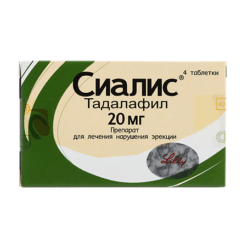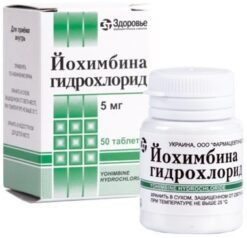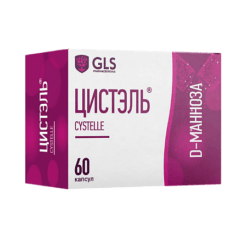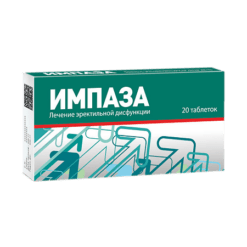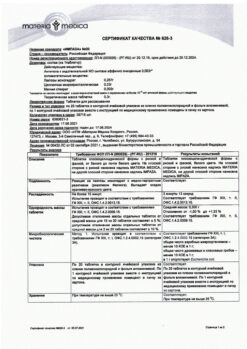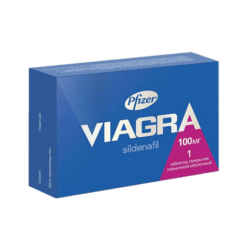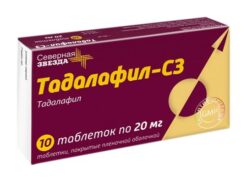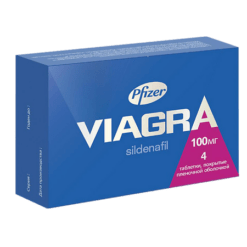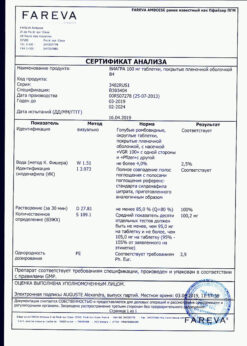No products in the cart.
Cialis, 20 mg
€53.43 €46.30
Out of stock
(E-mail when Stock is available)
Description
Tadalafil is a reversible selective inhibitor of specific FDE-5 cGMP. When sexual arousal causes local release of nitric oxide, inhibition of FDE-5 by tadalafil leads to increased concentration of cGMP in the cavernous body of the penis. The consequence of this is relaxation of arterial smooth muscles and blood flow to the tissues of the penis, which causes an erection. Tadalafil has no effect in the absence of sexual arousal.
In vitro studies have shown that tadalafil is a selective inhibitor of FDE-5. FDE-5 is an enzyme found in the smooth muscles of the cavernous body, in vascular smooth muscles of internal organs, in skeletal muscles, platelets, kidneys, lungs and cerebellum. The action of tadalafil on FDE-5 is more active than on other FDEs. Tadalafil is 10,000 times more powerful against FDE-5 than against FDE-1, FDE-2, FDE-4 and FDE-7, which are localized in heart, brain, blood vessels, liver, white blood cells, skeletal muscles and other organs.
Tadalafil is 10,000 times more active in blocking FDE-5 than FDE-3, an enzyme found in the heart and blood vessels. This selectivity for FDE-5 over FDE-3 is important because FDE-3 is an enzyme involved in heart muscle contraction. In addition, tadalafil is about 700 times more active against FDE-5 than against FDE-6, which is found in the retina and is responsible for phototransmission.
Tadalafil is also 9,000 times more potent against FDE-5 compared to its effect on FDE-8, FDE-9 and FDE-10 and 14 times more potent against FDE-5 compared to FDE-11. The tissue distribution and physiological effects of FDE-8 to FDE-11 inhibition have not yet been elucidated.
Tadalafil improves erection and increases the ability to have a full sexual intercourse.
Tadalafil in healthy subjects causes no significant change in BP and BP compared to placebo in the supine position (mean maximum reduction is 1.6/0.8 mm Hg, respectively) and in the standing position (mean maximum reduction is 0.2/4.6 mm Hg, respectively). Tadalafil causes no significant change in HR.
Tadalafil does not cause changes in color recognition (blue/green), which is due to its low affinity for FDE-6. In addition, there is no effect of tadalafil on visual acuity, electroretinogram, intraocular pressure and pupil size.
To evaluate the effect of daily tadalafil administration on spermatogenesis, several studies have been conducted. No adverse effect on sperm morphology and motility was observed in any of the studies. One study found a decrease in average sperm concentration compared to placebo. The decrease in sperm concentration was associated with a higher frequency of ejaculation. In addition, there was no adverse effect on the average concentration of sex hormones, testosterone, LH and FSH when taking tadalafil compared to placebo.
The efficacy and safety of Cialis (in doses of 2.5 mg and 5 mg) have been studied in clinical trials. Improvement of erections in patients with erectile dysfunction of all degrees of severity when taking tadalafil once a day has been noted. In studies of the primary efficacy of tadalafil at a dose of 5 mg, 62% and 69% of sexual attempts were successful, compared with 34% and 39% of patients taking placebo. Taking tadalafil at the 5 mg dose significantly improved erectile function for 24 hours between doses.
The mechanism of action of tadalafil in patients with BPH is tadalafil inhibition of FDE-5, resulting in increased concentration of cGMP in the cavernous body of the penis, is also observed in the smooth muscles of the prostate, bladder and the vessels that supply them with blood. Relaxation of vascular smooth muscles leads to increase of blood perfusion in these organs and, as a consequence, to reduction of BPH symptoms expression. Relaxation of the smooth muscles of the prostate and bladder may additionally enhance vascular effects.
Pharmacokinetics
Intake. After oral administration, tadalafil is rapidly absorbed. Mean Cmax in plasma is reached on average 2 h after oral administration. The speed and degree of absorption of tadalafil do not depend on the intake of food, so the drug Cialis can be used regardless of food intake. The time of intake (morning or evening) had no clinically significant effect on the speed and degree of absorption.
The pharmacokinetics of tadalafil in healthy subjects are linear with respect to time and dose. In the dose range of 2.5 to 20 mg, the AUC increases in proportion to the dose.
The pharmacokinetics of tadalafil in patients with erectile dysfunction is similar to the pharmacokinetics of the drug in persons without erectile dysfunction.
Distribution. Plasma Css are reached within 5 days when the drug is taken once daily.
The average Vd is about 63 L, indicating that tadalafil is distributed in body tissues.
In therapeutic concentrations, 94% of tadalafil in plasma is bound to proteins.
In healthy individuals, less than 0.0005% of the administered dose is found in semen.
Metabolism. Tadalafil is mainly metabolized with participation of cytochrome P450 isoenzyme CYP3A4. The main circulating metabolite is methylcatecholglucuronide. This metabolite is at least 13,000 times less active against FDE-5 than tadalafil. Consequently, the concentration of this metabolite is not clinically significant.
Elimination. In healthy individuals, the average clearance of tadalafil when taken orally is 2.5 L/h, and the average T1/2 is 17.5 h. Tadalafil is excreted primarily as inactive metabolites, mostly in the feces (about 61% of the dose) and to a lesser extent in the urine (about 36% of the dose).
Particular populations
Elderly patients. Healthy elderly patients (65 years and older) had lower clearance of tadalafil when taken orally, as reflected by a 25% increase in AUC compared with healthy individuals aged 19 to 45 years. This difference is not clinically significant and does not require dose adjustment.
Patients with renal impairment. No dose adjustment is required in persons with mild to moderate renal impairment. Due to the increased exposure of tadalafil (AUC), it is not recommended to use Sialis in patients with severe renal impairment.
Patients with hepatic impairment. Pharmacokinetics of tadalafil in patients with mild to moderate hepatic impairment are comparable to those in healthy subjects. No data are available for patients with severe hepatic impairment (Child-Pugh class C). When prescribing Cialis to patients with severe hepatic impairment, a risk-benefit assessment should be performed before using the drug.
Patients with diabetes mellitus. In patients with diabetes mellitus during tadalafil administration the AUC was lower by approximately 19% than in healthy subjects. This difference does not require a dose adjustment.
Indications
Indications
Active ingredient
Active ingredient
Composition
Composition
1 film-coated tablet contains:
the active ingredient:
tadalafil 20 mg;
excipients:
Lactose monohydrate;
Lactose monohydrate (spray-dried);
Hyprolose;
Hyprolose (extra fine);
Sodium lauryl sulfate;
microcrystalline cellulose;
MCC;
croscarmellose sodium;
magnesium stearate (vegetable);
film shell:
Opadry yellow (Y-30-12863-A) (lactose monohydrate, hypromellose, titanium dioxide, triacetin, iron oxide yellow dye)
How to take, the dosage
How to take, the dosage
The use of the drug Cialis for the indication of ED. For patients with frequent sexual activity (more than 2 times a week): the recommended frequency of administration is daily, once a day, 5 mg, at the same time, regardless of meals. The daily dose may be reduced to 2.5 mg, depending on individual sensitivity.
For patients with infrequent sexual activity (less than 2 times a week): It is recommended to prescribe Sialis in a dose of 20 mg, immediately before sexual activity, according to the instructions for medical use of the drug. The maximum daily dose of Sialis is 20 mg.
The use of Sialis for the indication of BPH or ED/DPH. The recommended dose of Sialis when used once a day is 5 mg; the drug should be taken at approximately the same time of the day, regardless of the time of sexual activity. The duration of treatment is determined by the doctor individually. In patients with renal insufficiency of mild degree of severity (creatinine Cl from 51 to 80 ml/min) and of moderate degree of severity (creatinine Cl from 31 to 50 ml/min) no dose adjustment is required.
In patients with severe renal impairment (creatinine Cl once daily is not recommended.
Interaction
Interaction
The effect of other drugs on tadalafil
Tadalafil is mainly metabolized with participation of the CYP3A4 isoenzyme. Selective CYP3A4 isoenzyme inhibitor ketoconazole (400 mg/day) increases AUC of tadalafil at a single dose by 312% and Cmax by 22%, and ketoconazole (200 mg/day) increases AUC of tadalafil at a single dose by 107% and Cmax by 15% relative to AUC and Cmax values for tadalafil alone. Ritonavir (200 mg 2 times per day), an inhibitor of CYP3A4, 2C9, 2C19 and 2D6 isoenzymes, increases AUC of tadalafil in single dose by 124% without changing Cmax. Although specific interactions have not been studied, other HIV protease inhibitors, such as saquinavir, and CYP3A4 isoenzyme inhibitors, such as erythromycin and itraconazole, can be expected to increase tadalafil activity.
The selective CYP3A4 isoenzyme inducer, rifampicin (600 mg/day), reduces single-dose tadalafil exposure (AUC) by 88% and Cmax by 46% relative to the AUC and Cmax values for tadalafil alone. It can be assumed that concomitant use of other CYP3A4 isoenzyme inducers should also reduce plasma concentrations of tadalafil.
Concomitant administration of an antacid (magnesium hydroxide/aluminum hydroxide) and tadalafil reduces the rate of absorption of tadalafil without changing the area under the pharmacokinetic curve for tadalafil. An increase in gastric pH due to administration of the H2-histamine receptor blocker nizatidine had no effect on the pharmacokinetics of tadalafil.
The safety and effectiveness of combinations of tadalafil with other treatments for erectile dysfunction have not been studied, so these combinations are not recommended.
Tadalafil does not potentiate the increase in bleeding time caused by taking acetylsalicylic acid.
The effect of tadalafil on other drugs
Tadalafil is known to increase the hypotensive effect of nitrates. This is due to the additive effect of nitrates and tadalafil on nitric oxide (NO) and cGMP metabolism. Therefore, the use of tadalafil with nitrates is contraindicated.
Tadalafil has no clinically significant effect on the clearance of drugs metabolized with cytochrome P450. Studies have confirmed that tadalafil does not inhibit or induce the CYP1A2, CYP3A4, CYP2C9, CYP2C19, CYP2D6, CYP2E1 isoenzymes.
Tadalafil has no clinically significant effect on the pharmacokinetics of S-warfarin or R-warfarin. Tadalafil does not affect the effect of warfarin on PV.
Tadalafil does not increase the duration of bleeding caused by acetylsalicylic acid.
Tadalafil has systemic vasodilator properties and may increase the effect of hypotensive drugs to reduce BP.
In addition, a slightly greater decrease in BP was observed in patients who were taking multiple hypotensive agents in whom arterial hypertension was poorly controlled. In the vast majority of patients, this decrease was not associated with hypotensive symptoms. Patients treated with hypotensive medications and taking tadalafil should be given appropriate clinical advice.
There was no significant decrease in BP when tadalafil was used in healthy subjects taking the selective alpha1A-adrenoblocker tamsulosin in two clinical studies.
The concomitant use of tadalafil with doxazosin is contraindicated. When tadalafil was used in healthy volunteers who were taking doxazosin (4-8 mg/day), an alpha1-adrenoblocker, an increase in the hypotensive effect of doxazosin was observed. Some patients experienced symptoms associated with a decrease in BP, including fainting.
Tadalafil did not affect alcohol concentration, nor did alcohol affect tadalafil concentration. At high doses of alcohol (0.7 g/kg), tadalafil administration did not cause a statistically significant decrease in mean BP. Postural dizziness and orthostatic hypotension were observed in some patients. When tadalafil was taken in combination with lower doses of alcohol (0.6 g/kg), no BP reduction was observed, and dizziness occurred with the same frequency as when alcohol alone was taken.
Tadalafil has no clinically significant effect on the pharmacokinetics or pharmacodynamics of theophylline.
Special Instructions
Special Instructions
Sexual activity has potential risks for patients with cardiovascular disease. Therefore, treatment of ED, including with Cialis, should not be performed in men with heart disease in which sexual activity is not recommended.
There have been reports of priapism when using FDE-5 inhibitors, including tadalafil. Patients should be informed to seek immediate medical attention if an erection lasts 4 hours or more. Failure to treat priapism in a timely manner leads to damage to penile tissue, which may result in irreversible impotence.
The safety and efficacy of combinations of Cialis with other FDE-5 inhibitors and ED treatments have not been studied. Therefore, the use of such combinations is not recommended.
Like other FDE-5 inhibitors, tadalafil has systemic vasodilator properties, which may lead to a transient decrease in BP. Before prescribing Cialis, physicians should carefully consider whether patients with cardiovascular disease would be adversely affected by such vasodilating effects.
NAPION is a cause of visual impairment, including total loss of vision. There are rare post-marketing reports of cases of the development of NAPION that are time-related to the intake of FDE-5 inhibitors. At this time, it is not possible to determine whether there is a direct association between the development of NAPION and the intake of FDE-5 inhibitors or other factors. Physicians should advise patients in the event of sudden vision loss to discontinue tadalafil and seek medical attention. Physicians should also advise patients that people who have had NAPION have an increased risk of developing NAPION again.
Patients with a suspected diagnosis of BPH should be screened to rule out prostate cancer.
The efficacy of Cialis in patients who have undergone pelvic surgery or radical neurosurgical prostatectomy is unknown.
The effect on the ability to drive and perform work requiring increased speed of psychomotor reactions. Although the incidence of dizziness is similar between placebo and tadalafil, caution should be exercised during treatment when driving motor vehicles and engaging in other potentially hazardous activities requiring increased concentration and rapid psychomotor reactions.
Contraindications
Contraindications
Side effects
Side effects
The most common adverse events in patients with ED are headache and dyspepsia, as well as back pain, myalgia, flushes to the face, and nasal congestion.
The most common adverse events in patients with ED/DHP are headache and dyspepsia, pain in the extremities, gastroesophageal reflux, and myalgia.
Immune system disorders:infrequent (â¥0.1%,
Nervous system disorders: very common (â¥10%), headache; common (â¥1%, 1, transient ischemic attacks1, migraine3, epileptic seizure, transient amnesia.
Visual organs: infrequent (â¥0.1%, 3, retinal vascular occlusion3.
Hearing organ and labyrinth disorders: rare (â¥0.01%,2.
Systems side: infrequent (â¥0.1%, 3, unstable angina pectoris3.
Respiratory system disorders:infrequent (â¥0.1%,
Gastrointestinal disorders:frequent (â¥1%,
Skin and subcutaneous tissue disorders: infrequent (â¥0.1%,3, exfoliative dermatitis3.
Musculoskeletal and connective tissue disorders:common (â¥1%,
Genital and mammary gland disorders: rare (â¥0.01%,3.
General disorders: infrequent (â¥0.1%, 1; rare (â¥0.01%, 3, sudden cardiac death1,3.
1 Observed in patients with previous cardiovascular risk factors. However, it is not possible to definitively determine whether these events are directly related to these risk factors, tadalafil, sexual arousal, or a combination of these or other factors.
2 Sudden hearing loss has been reported in a small number of cases from postmarketing and clinical studies with all FDE-5 inhibitors, including tadalafil.
3 Adverse reactions found in post-marketing studies not observed in clinical placebo-controlled studies.
Overdose
Overdose
When tadalafil was administered to healthy individuals in a single dose up to 500 mg and to patients with ED in multiple doses up to 100 mg/day, the adverse effects were the same as when lower doses were used.
Treatment: in case of overdose, standard symptomatic treatment should be administered. In hemodialysis tadalafil is practically not excreted.
Pregnancy use
Pregnancy use
The drug Cialis is not intended for use in women.
Similarities
Similarities
Additional information
| Shelf life | 3 years |
|---|---|
| Conditions of storage | At a temperature not exceeding 30 °C |
| Manufacturer | Lilly del Caribe Inc., Puerto Rico |
| Medication form | pills |
| Brand | Lilly del Caribe Inc. |
Other forms…
Related products
Buy Cialis, 20 mg with delivery to USA, UK, Europe and over 120 other countries.

